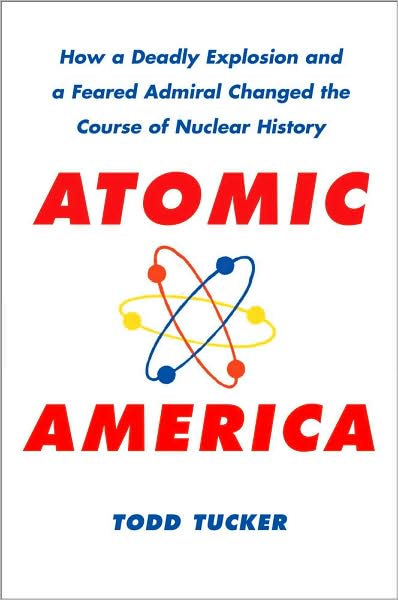

| ATOMIC AMERICA How a Deadly Explosion and a Feared Admiral Changed the Course of Nuclear History Todd Tucker New York: Free Press, 2009 |
Rating: 5.0 High |
|||
| ISBN-13 978-1-4165-4433-3 | ||||
| ISBN 1-4165-4433-X | 277pp. | HC/BWI | $26.00 | |
This book opens with an account of the explosion of the Army SL-1 reactor on 3 January 1961 at the National Reactor Testing Station in southeastern Idaho. The explosion, caused by a reactivity burst when a control rod was withdrawn too far, killed the three operators present at the time. It remains the only fatal reactor accident caused by nuclear fission1 in American history.2
The complete story of SL-1 is neither a murder mystery nor a love story. It is more than an engineering case study as well, an incident that cannot be explained completely with flux diagrams and reactivity calculations. The story of SL-1 is a war story, a tale of a bloody, costly struggle between the three branches of the U.S. military. – Page 7 |
Tucker provides what I believe is the most complete description in a popular book of SL-1 and the causes of its destruction, and the events that flowed from that destruction. He interleaves this account with coverage of each service's exploitation of atomic power. The Navy's effort, led by Admiral Hyman G. Rickover, comes first, and Rickover looms large throughout the book, as he did in real life. The outstanding success of the Navy's nuclear reactor program is down to him: he set the standards and with a combination of bluster and adroit political maneuvering, pushed them through. When he retired after 63 years of active duty, the Navy boasted 121 atomic submarines, three aircraft carriers powered by fission, and nine other nuclear surface warships.
Rickover's nuclear Navy was no place for slackers. He vetted every candidate for the service personally, in a harrowing interview. And woe betide any Navy man or contractor who tried to cut corners. Tucker tells of a time when a small pipe cracked in the course of dockside tests on the Nautilus, the first atomic submarine. When the pipe was found to be a lower grade than specified, Rickover insisted that every inch of pipe in the system be ripped out and replaced. The Navy's record of reactor safety rests on his demand for top-grade personnel and equipment. To a degree, the same is true of commercial nuclear power plants, for many of their workers come out of the Navy.3
Near the end of his life Rickover revealed that he saw nuclear power as a necessary evil, a technology he would never have embraced had he not felt it vital to the survival of the United States. The Army had a much more pedestrian philosophy about nuclear technology. This is seen in the casual way they developed a veritable zoo of nuclear munitions, from Atomic Annie, an 83,000-pound behemoth which fired 15-kiloton shells to a 51-pound projectile with a 1-kiloton yield that a four-man team in a jeep could deploy. It also did a lot of work on portable reactors for outposts like the DEW Line of the Cold War. SL-1 cast a dark shadow over this program. Despite that, the Army made a success of their portable nuclear power sources program, while the munitions fell by the wayside.
And then we come to the Air Force. The most intense rivalry existed between them and the Navy. Air Force doctrine was that fighting ships were obsolete in the age of air power. They had the B-36 with its 8,700-mile range, and later the B-47 and workhorse B-52 of the Strategic Air Command. The great dream of Air Force leadership, well supported by allies in Congress, was to build a fission-powered bomber that would have essentially unlimited range and endurance. Over a 15-year period, some $1 billion was spent on this goal. The program never even built a working engine prototype, much less got an airplane off the runway. John Kennedy courageously killed the program just after taking office in 1961.
At one point I felt that Tucker was devoting too much attention to the human side of the SL-1 tragedy. But as I read further I decided that this was the point he was trying to demonstrate. For in the end he concludes that there is no real evidence for the allegations of bitterness between Byrnes and Legg over a love triangle, or of Byrnes's despair due to his dissolving marriage. In contrast, there is abundant evidence that SL-1 was badly designed and sloppily maintained — an accident waiting to happen. Despite this, Tucker notes, the juicy rumors appear in almost every account of the accident. He observes that such explanations take at least some of the heat off the manufacturers and operators of the reactor.
Nor does Tucker miss the larger picture: the way the tensions of the Cold War exacerbated inter-service rivalries and encouraged spending on a host of poorly conceived weapons systems. Through diligent research, he has put together a very readable and insightful account. It is supplemented by 22 black and white photographs, thoroughly end-noted, and includes a list of sources with 64 books, 73 articles and letters, 12 speeches, 25 government publications, 6 films and DVDs, 1 legal document, and 17 interviews. There are two false statements, some grammatical errors, and the indexing is only fair. Nevertheless, the wealth of information and insight this book provides merits top marks, and the way it weaves together so many disparate stories to illuminate the larger picture makes it a definite keeper.

 To contact Chris Winter, send email to this address.
To contact Chris Winter, send email to this address.